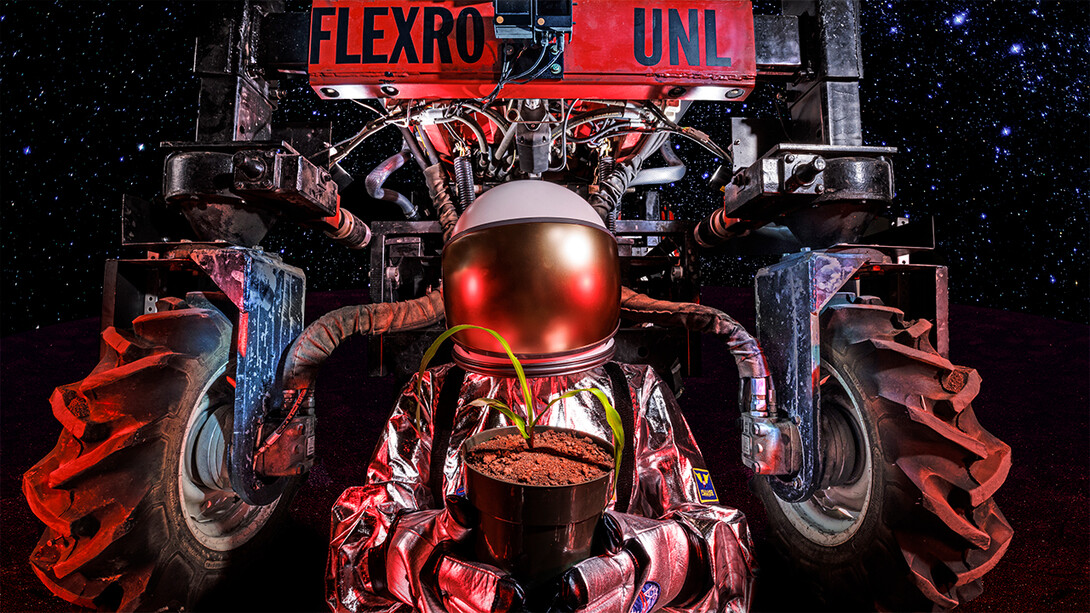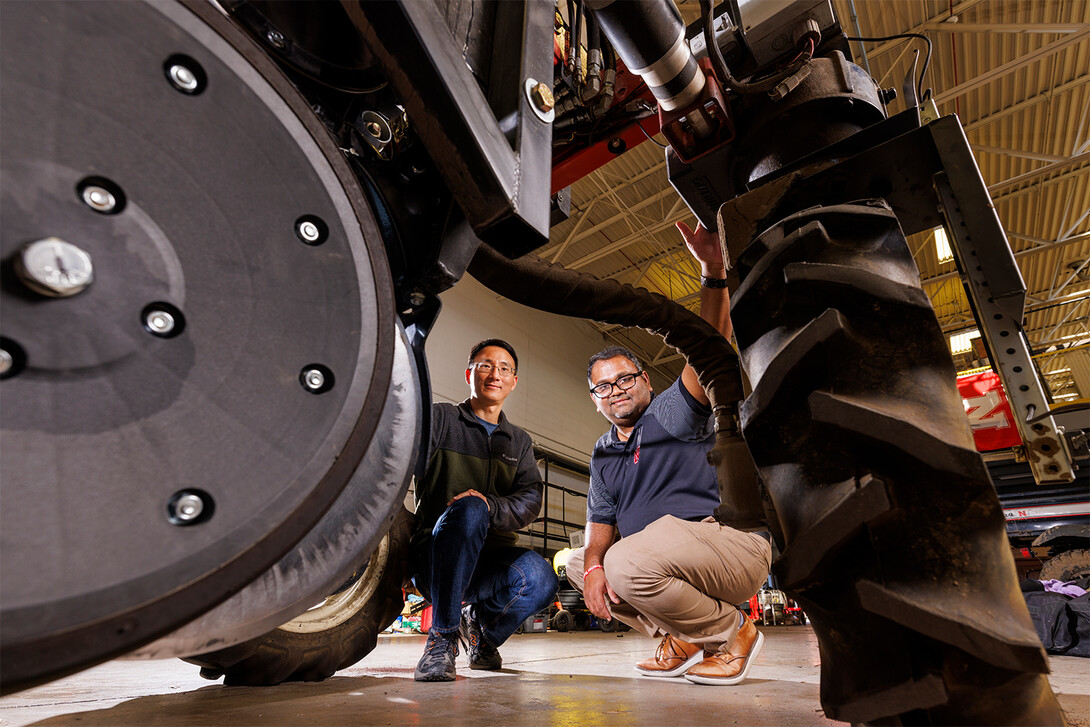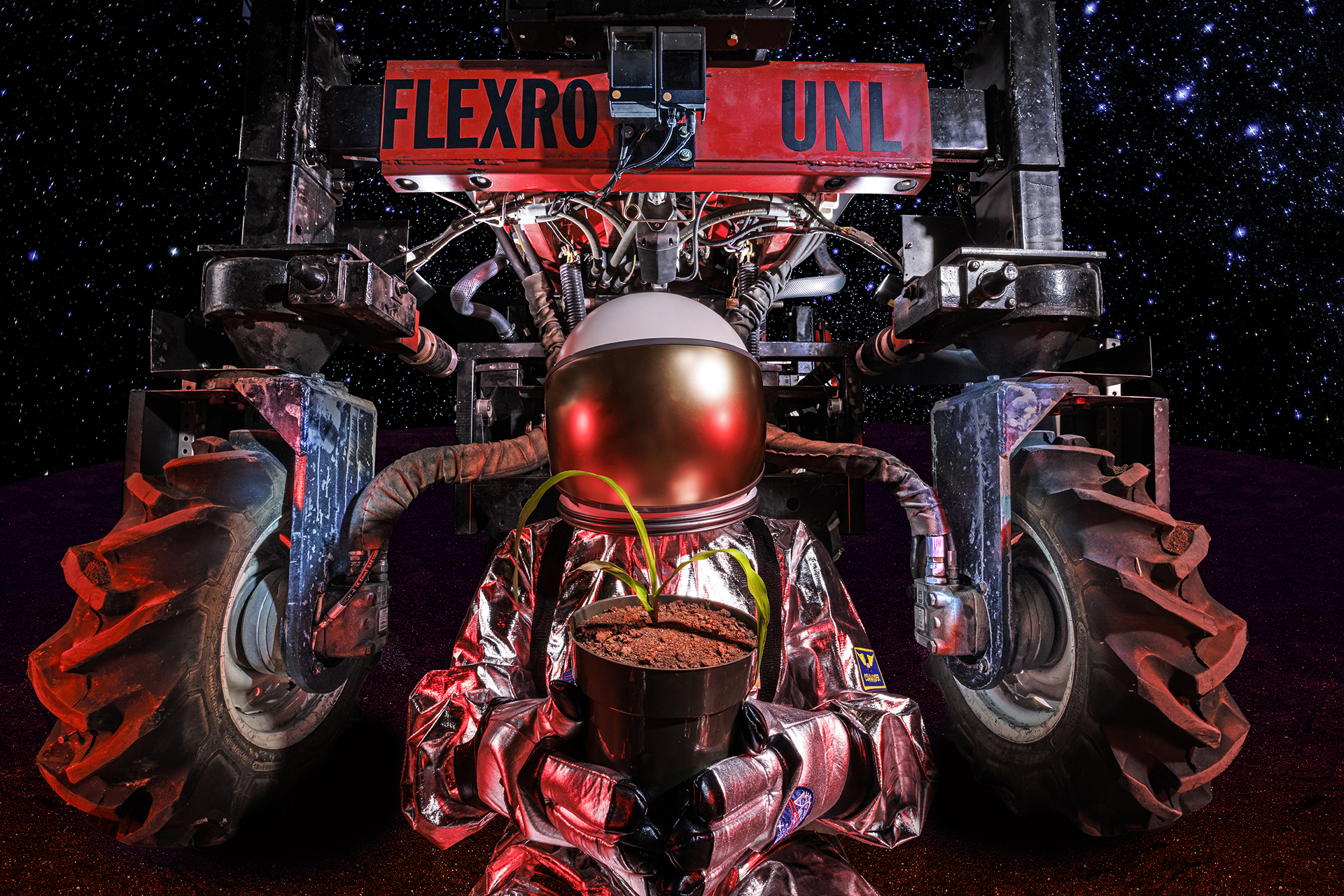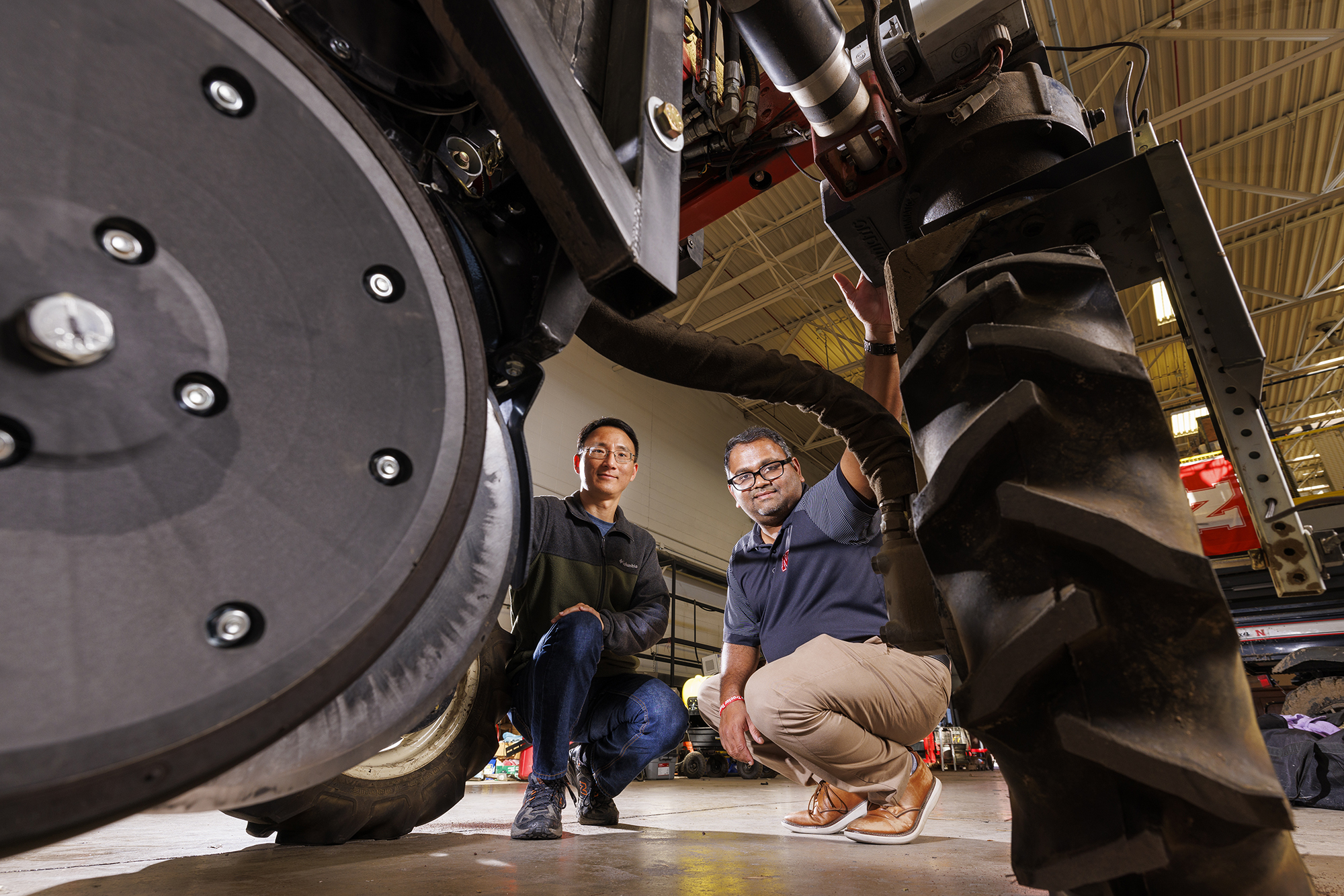
It’s little wonder that so much of the early research into space exploration would orbit around escaping gravity’s grip, or that the source of that escape, the rocket, would occupy so many minds with the cosmic ambition to match their intellect.
But that ambition fueled the race to space at least as much as liquid hydrogen did. And so, as Nebraska U’s Yufeng Ge and Santosh Pitla witnessed the astronomical advances of their own era — reusable rockets landing back on Earth, a drone taking flight on Mars — the Husker engineers began thinking big about an aspect of space travel just obvious enough to often escape attention.
“We’ll be on Mars and the moon, we’ll have settlements — and people got to eat,” said Pitla, associate professor of biological systems engineering.
Before long, the duo was applying for and earning a two-year Grand Challenges grant from Nebraska’s Office of Research and Economic Development. Ge and Pitla’s long-term goal is about as grand as it gets: finding ways to sustainably grow food on space stations, the moon, Mars and other celestial bodies that might eventually sustain legions of the human kind. To do it, they formed the Consortium of Space, Policy, Agriculture, Climate and Extreme Environment — SPACE2, for short.
The consortium’s short-term aim doesn’t exactly lean modest, either. It may not rank with the near-vacuum of space, but Ge and Pitla would come to learn of a sizable void: No U.S. university features a center dedicated specifically to the study of space agriculture. The researchers want Nebraska to house the first.
“If NASA or the big space companies — SpaceX, Virgin Galactic, Blue Origin — want to go out and work with a university, who would that be?” Pitla said. “We have been doing ag research for more than 100 years, and we’re an ag state.
“Why reinvent the wheel somewhere else when we already have all this experience?”
It helps, Ge said, that Nebraska U “sits very, very nicely in that intersection” of multidisciplinary expertise and force-multiplier collaboration that the rigors and relentlessness of space will demand. The university-housed Daugherty Water for Food Global Institute, the recent recipient of a $19 million grant to pursue sustainable irrigation and mechanization in developing countries, has long endeavored to grow more food with less water. Ge’s own research into ag-relevant sensors is likewise informing more precise, efficient application of fertilizer and water, both of which will prove even more precious in space than on Earth. Pitla has spearheaded the engineering and testing of Flex-Ro, an autonomous planter that can already seed a 5-acre, untilled field on its own.
“Before humans go to Mars, we’ll want some essential resources there — and for that, we will send robots,” Pitla said. “Think about a greenhouse on a spaceship that’s landed on Mars, and it’s already started growing food. You need a fully automated, robotic farmer that is doing those things even before humans arrive.”

The Department of Agronomy’s work in plant genetics, meanwhile, gets applied at the Greenhouse Innovation Center, where a combination of infrared cameras and AI-powered imaging analysis has accelerated the breeding of crop varieties that endure amid temperature extremes and drought.
“The only difference between that and what we’ll be doing in space is, well, nothing,” said David Jones, a member of the team and professor of biological systems engineering. “Space is another extreme environment.”
In assembling their consortium, the engineers were careful not to overlook the value of related but less obvious expertise. They invited multiple colleagues from the Nebraska College of Law, which has emerged as an international leader in the thorny, unprecedented realm of legality and ownership in space. And they folded in faculty from the Johnny Carson Center for Emerging Media Arts, whose ability to conceptualize the future has already given the engineers and scientists plenty to chew on.
“If it’s not going to work here,” Jones said of a space ag center, “it’s not going to work.”
*******As formidable and faceted as the consortium is, Ge, Pitla and Jones suffer no illusions about the magnitude of the task before them. The Earth’s atmosphere, and its Goldilocks-perfect proximity to the star it orbits, often obscure just how unforgiving the vast majority of the vast universe can be. That’s no less true when it comes to growing food, as the team’s preliminary research has underscored.
Ehsan Fazayeli, a doctoral student advised by Pitla and Ge, has reviewed the existing research on eating and farming in space. Some of the numbers are especially sobering: A four-person crew heading for Mars, and wanting to eat three meals a day, would need to haul 24,000-plus pounds of food.
That makes a stellar case for growing some on the way there, whether in conventional soil, in nutrient-rich water (hydroponics) or suspended in air (aeroponics), with vapor alone delivering the necessary nutrients. NASA has experimented with each on the International Space Station.
“I think we’ll have to rely on all those technologies complementarily,” said Ge, professor of biological systems engineering. “I doubt that any technology is so dominant that we say, ‘This is the one to go with.’”
Though hydro- and aeroponics use fewer overall resources, they will still rely on the recycling of water and nutrients — a closed-loop system that requires a rewiring of an Earth-bound mindset, Jones said.
“We (currently) have a lot of linear systems,” he said. “There are inputs and there are outputs, and we don’t really recapture them. But whether it’s a spaceship or in residence, we better have that figured out, or we will fail. The bottom line is that the logistics and opportunities of taking (food) with you, or growing it there, are so limited, and the stakes are really high.”
The challenges won’t abate once a crew finally touches down with the intent to settle down. Mars receives less of the visible light that powers photosynthesis — and more of the DNA-damaging high-energy radiation that Earth’s atmosphere helps shield against. Temperature fluctuates wildly, too: Whereas a summer day at the red planet’s equator can reach a comfortable 70 degrees Fahrenheit, a summer night there might plummet to minus 100.
The fact that Mars offers just 38% of Earth’s gravity will present its own issues. Among the trickiest? Directing the flow of irrigation, without expending scores of energy, when gravity goes from a reliable assistant to more of a lazy bystander. Generating enough downforce to plant seeds at sufficient depth won’t be easy, either, and might necessitate power-hungry tech to compensate for the fractional gravity.
Then there’s the soil itself. The best of Earth’s enjoys water, carbon-rich organic matter and, in just a single teaspoon of the stuff, billions of microorganisms that help convert nitrogen into a life-sustaining form that gets taken up by neighboring plant roots. By comparison, the moon’s — a combination of rock fragments, dust and glass-fused minerals collectively known as regolith — pales not just in color but performance.
Doctoral student Cassie Palmer has put that lunar regolith to the test by planting soybean in an imitation of it. At the Greenhouse Innovation Center, she tracked the soybean’s growth against that planted in conventional soil. Unfortunately, the shoots of the lunar-planted soybean struggled mightily to sprout throughout a 40-day span. Its roots did the same, though they also outpaced the relative growth of the shoots, apparently in a futile attempt to find nutrients that Palmer would show to be missing from the regolith.
“They also have a low emergence rate,” Ge said. “For every three seeds you drop, only one comes out — which means that you need three times as many seeds.”
The lunar-like substrate even turned the act of watering it, a seeming no-brainer, into a headache of sorts. Unlike much of Earth’s soil, which will maintain pores that accommodate root growth when watered, the imitation regolith tended to solidify, sometimes damaging the root caps that facilitate root migration and nutrient uptake.
Palmer and Fazayeli would later swap out some of the regolith for soil — and the soybean for faster-germinating peas — during the Plant the Moon Challenge, a NASA-affiliated outreach program that the duo brought to Dawes Middle School and Lincoln Northeast High School. That outreach dovetails with what Ge sees as a natural opportunity to inspire Nebraska’s next generation of agronomists and farmers.
“I think that it is a very good topic,” he said, “to get them imagining what the future is going to look like.”
Ge conceded that, as a Husker attempting to envision that future, he initially saw corn. As some food scientists were keen to point out, though, soybean bests Nebraska’s signature crop when it comes to offering not just carbohydrates but protein and oils. And both crops require more processing than do leafy greens and root crops like carrots and potatoes. Less processing means less energy and, all other factors equal, a more desirable crop.
Still, corn and other Midwestern staples might eventually find a place on the surfaces of other planets, the researchers said, given that leftover stalks, leaves and the like can naturally fertilize soil with nitrogen, phosphorous and other vital nutrients.
“Yes, the first generation (of regolith) is really harsh for plants,” Ge said. “But hopefully, when you keep adding the corn stalks, soybean residues or some of the waste coming from other processes, you can improve it to the point that you can actually reasonably grow the plants.”
Deciding which crops should earn pride of place as the first grown on another planet rates as just one of many choices that could make or break a settlement effort, the team said. Which genes have been silenced by the environmental conditions of modern-day Earth but could reawaken, and help their crops flourish, on Mars? Does it make sense to include livestock or companion animals on a shuttle?
Having the luxury of making mistakes — a possibility granted by, say, running simulations at the university’s Holland Computing Center — could ultimately help maximize the odds of success.
“Back in the ’60s, we had this space race: ‘land a man on the moon and return them safely,’ and do it by the end of the decade,” Jones said. “We don’t have that deadline. But what I’ve envisioned is the scenario planning and modeling — What if you did plant corn? What’s the right crop mixture? — and being able to simulate it, to do it virtually, before we ever leave. We’d better do that quick if we’re actually going to get it done.”
*******For all its focus on long-distance propulsion and equally long-distance communication, NASA has hardly ignored the issue of growing food in space. So when Ge and Pitla formed SPACE2, it only made sense to touch base with the National Aeronautics and Space Administration.
“The difficult thing is to get your name out and establish your identity,” Ge said, “so that when people talk about the topic, they think about you.”
In spring 2023, the consortium secured a visit from Ray Wheeler, a plant physiologist and space ag pioneer who has worked at NASA’s Kennedy Space Center for the past 35 years. The team now hopes that a Husker graduate student can earn a fellowship at either the Kennedy Space Center or NASA’s Ames Research Center, where scientists study how biological processes fare in space.
Though the major private-industry players tend to keep their cards close to the chest, the consortium has also networked with Honeybee Robotics, a subsidiary of Blue Origin. And the Husker team has already established relationships with colleagues at several other Big Ten institutions, including Ohio State University, the University of Minnesota and the University of Illinois. Those colleagues will join representatives from NASA, Honeybee Robotics and the USDA’s National Institute for Food and Agriculture at a SPACE2-hosted symposium taking place Nov. 30 through Dec. 1.
The prominence and breadth of that guest list speaks to the nigh-countless challenges posed by the alien horizons of space, the researchers said. But the difficulties of growing food on Earth — where a still-expanding population threatens to worsen food shortages, where greenhouse gases raise temperatures and amplify drought — continue to mount, too. Any lessons learned while conjuring ways to better cultivate food in space, the team said, should apply to the extremes of home.
“I think this process is going to teach us a lot,” Ge said. “Nobody wants to see us go through catastrophic climate change. But if that happens, we (should) already have the technological know-how to address those problems.”
“If we do this mission planning, we will make some really hard decisions,” Jones said. “That exercise of making those hard decisions, and tracking the impact of those decisions, is going to be useful when we have to make decisions here and now. What are those trade-offs? What are the costs of them? Sometimes it’s easier to imagine that decision-making in a fictional world … than it is to think about it in the here and now.”
Yet the inverse is also true, Pitla said. For decades, humanity has considered and planned for all that would go into departing Earth. It feels like the time, he said, to shift some attention from the mission — the launch, the travel, the landing — to what comes after.
“We have been focusing on the journey. What happens when you get to the destination?”









